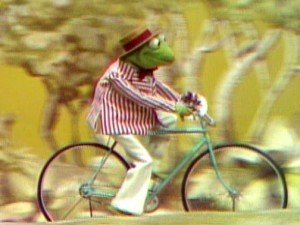The Muppets Valentine Show
In 1973, Jim Henson decided to once again pitch a TV variety show starring the Muppets, which had been a goal of his since all the way back in the immediately-post-Sam-and-Friends era but which had always failed to come to fruition due to American network executives not being able to get over their bias that puppets were for children, despite all the evidence as to how much adult audiences enjoyed the Muppets when they made appearances on other peoples’ shows and even on Sesame Street.
Jim’s written pitch announced that the “time is right for a variety show hosted by dogs, frogs, and monsters…The show is aimed at the adult or young adult audience, but it is a show for the whole family…The Muppets, more than any other puppets, are more real than the real thing.” And, as it so happens, a young executive at ABC who would later go on to be the CEO of the Walt Disney Company, Michael Eisner, loved the Muppets and was impressed with Jim’s proposal and so greenlit a Muppet pilot for the network, which began filming on December 3, 1973, with special guest star, Mia Farrow. It aired shortly afterwards on January 30th of 1974 to strong ratings and extremely positive reviews. Even this, however, enough to turn The Muppet Show into a series. Instead, ABC agreed to develop other programs with Jim, including another Muppet pilot/special, meaning The Muppets Valentine Show wasn’t a complete failure, but it fell far short of Jim’s hopes and expectations.
And it makes for fascinating viewing today (you can watch it on The Muppet Show Season 2 DVD set) both for its similarities with The Muppet Show that would eventually, finally come to fruition another 2 years later, as well as for its extreme differences. In many ways, the DNA for the show that we know and love today is there right from the start. Much of it, from the eclectic musical numbers that include lesser-known Broadway showtunes and traditional English folk and musical hall songs to the single human guest star surrounded by full-on Muppety chaos to the zany sketches–one of which, about the mating rituals of the aliens on the planet Koozebane, would be recreated and become a recurring sketch on The Muppet Show–could easily have come straight out of the Muppet Theatre.
Furthermore, the pilot also introduces a number of new characters who would recur on The Muppet Show, albeit many of them only or mainly in the first season of the show, including George the Janitor, Mildred (a purple-colored, middle-aged aristocratic lady with a beak-shaped nose), and Brewster (an old, bald, bearded guy often known as “the Guru”), along with ones who had longer Muppet Show lives, such as Miss Mousey, the aforementioned Koozebanians, and Crazy Harry (who was called “Crazy Donald” here, for Don Sahlin, the Muppets’ master puppet builder, who was fond of practical jokes and explosions).
But there are also many huge differences. Most glaring is probably that Kermit isn’t the host. He does have an extremely memorable scene and musical number that could easily stand side-by-side with many of The Muppet Show‘s best, and which also happens to feature Kermit actually riding a bicycle (frog legs visible and all) years before he more famously stunned audiences doing so on the big screen in The Muppet Movie and The Great Muppet Caper.
But, other than that, he’s a supporting player at best and this is likely largely due to Jim trying to draw a sharper delineation between this new show and Sesame Street. He had caught flack for having Kermit appear in Hey Cinderella! years earlier, when at least one prominent critic had argued that he was trying to commercialize a Sesame Street character (even though Kermit had been around for a long time by that point, and Hey Cinderella! itself had been filmed 2 years earlier), which made him a bit gun shy about centering a show around Kermit. Part of him also probably wanted to try something new rather than continuing to fall back on the frog.
This clearly wasn’t the right decision, however, as Kermit is just more naturally suited to being the central figure, the mostly level-headed protagonist at the eye of the crazy Muppet storm–as he’d already proven both in his narrator positions in Tales from Muppetland as well as in his lectures on Sesame Street–not just another inmate in the mad house, and when he is just one of the many other Muppets here, something about it just doesn’t feel right. Meanwhile, the host of this episode, a cool, sunglasses-clad guy called Wally, who Jim plays with his gruffer Dr. Teeth/Rowlf voice, is mostly unmemorable. Throughout the show, he sits and clacks away at a typewriter, waxing philosophically about the concept of love, and that’s about it. It’s not particularly surprising that he never appeared in another Muppet production. The most interesting thing about him is that, physically, he’s a slightly reconstructed version of Fred the Elf from The Great Santa Claus Switch…and that’s about it.
More problematically, however, the show just doesn’t quite know what it wants to be yet. As I said before, the musical numbers and sketches are mostly solid, but it’s severely lacking in strong storytelling structure. Unlike The Muppet Show, which revolved around the concept of the Muppets putting on a weekly vaudeville show in an old theatre, The Muppets Valentine Show has the Muppets all frolicking around a big house for no particular reason and never answers questions such as whether they’re all supposed to actually be living there and why a house would require a janitor (a butler, maid, or some sort of cleaning staff, sure, but a janitor is pretty public-building-specific).
Furthermore, without the putting-on-a-show framework, which gave the later show and its characters a unified goal and drive, the characters here are basically left to flail around, as if they themselves are desperately trying to come up with material that fits the “love” theme of the episode, without any internal story reason for them to be doing so.
What was so genius about The Muppet Show‘s concept and has allowed it to age so well, on the whole, is its structure. It isn’t a typical 1970s variety show because it’s actually about putting on a variety show, and specifically a type of a variety show that was already ancient then, meaning (a) it even felt out of its own time, and (b) the Muppets’ oddball, underdog status was woven in right there from the start. At the same time, it allowed for backstage stories which complemented the sketches and musical numbers, some of which stood alone and others of which were directly related to the episode’s plot. It also made the Muppet Theatre feel like a distinct, lived-in place, a micro-universe populated by and stuffed to the brim with the strangest creatures but which simultaneously felt so real you could imagine yourself stepping right through the TV and visiting it, much as Walter did in his dream sequence at the start of the 2011 film, The Muppets.



